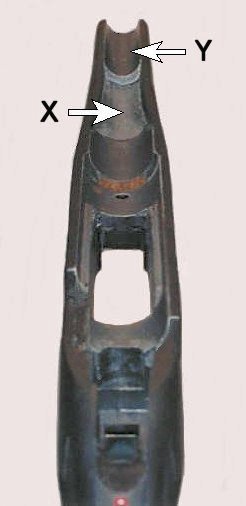
Free floating a rifle barrel always delivers the best
accuracy with heavy barrels, but it rarely works best on lightweight
barrels. The rifle stock on the left is the original factory
stock that came on my .300 Win. Mag. Browning Composite Stalker.
If you own one of these factory stocks, take a close look at the
forearm. You may not recognize that this is the same stock.
First, I bedded the action using Devcon Putty, and then I free
floated the barrel.
I always test rifles at this point, just to
evaluate the accuracy. As I suspected, the accuracy was not as
good as it should be. That is why most rifle manufacturers use
upward stock pressure on their sporter weight rifle barrels. The
Browning composite stocks look great and are rugged, but they're
nowhere near as solid as a top quality McMillan stock. However,
if you have the time and skill, you can make almost any factory stock
become very solid. (Be sure to seal the forearm on wood stocks
with polyurthane to prevent warping.) This composit forearm on
this rifle was originally hollow, with only a thin rib that added
almost no stiffness at all.
This stock required bedding two 3/8" x 5" hardened steel rods inside the forearm (located under the "X").
This added the badly needed forearm rigidity. Next, I added a 2.5" bedding platform (shown by the "Y")
in the forearm to provide upward pressure against the barrel.
When this is done properly, it stiffens the barrel considerably.
I've found that this procedure has worked extremely well for several
lightweight rifles that seemed to have little or no hope of becoming
good shooters. The snug fit of the action, and consistant upward
barrel tension is the trick to making most sporter weight rifles shoot
accurately.
After you bed the action and free-float the
barrel, you can then perform this separate bedding procedure to the
forearm. Make a separate contact surface (about 2.5" long) near the
front tip. During this final bedding operation you need to clamp
an 8 to 10 pound weight on the tip of the forearm. The bedding
needs to harden while the rifle is resting in a level position, with
the front of the rifle supported by the barrel. This forearm
platform will ensure that your stock will always deliver between 8 to
10 pounds of upward pressure against the barrel.
This particular stock was mostly hollow, and it
required cutting a few wood blocks to fill large recesses. These
wooden blocks need to be bedded far below your contact surfaces.
The rear of this stock was hollow, and adding a recoil pad turned out
to be quite a project. I bedded a large wooden block inside the
butt before attaching a Decellerator recoil pad. My Browning
.300 Win. Mag. now consistantly shoots 1/2" to 3/4" (5 shot groups) at
100 yards with handloads. If you do this procedure carefully,
you should have a rifle that appears just as it did when it left the
factory, except now it'll be a real tack driver.
